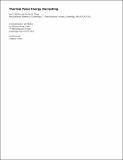Thermal pulse energy harvesting
Author(s)
McKay, Ian; Wang, Evelyn
DownloadEnergy_11-30-2012.pdf (1.749Mb)
PUBLISHER_CC
Publisher with Creative Commons License
Creative Commons Attribution
Terms of use
Metadata
Show full item recordAbstract
This paper presents a new method to enhance thermal energy harvesting with pulsed heat transfer. By creating a phase shift between the hot and cold sides of an energy harvester, periodically pulsed heat flow can allow an available temperature gradient to be concentrated over a heat engine during each thermal pulse, rather than divided between the heat engine and a heat sink. This effect allows the energy harvester to work at maximum power and efficiency despite an otherwise unfavorable heat engine–heat sink thermal resistance ratio. In this paper, the analysis of a generalized energy harvester model and experiments with a mechanical thermal switch demonstrate how the pulse mode can improve the efficiency of a system with equal engine and heat sink thermal resistances by over 80%, although at reduced total power. At a 1:2 engine–sink resistance ratio, the improvement can simultaneously exceed 60% in power and 15% in efficiency. The thermal pulse strategy promises to enhance the efficiency and power density of a variety of systems that convert thermal energy, from waste heat harvesters to the radioisotope power systems on many spacecraft.
Date issued
2013-06Department
Massachusetts Institute of Technology. Department of Mechanical EngineeringJournal
Energy
Citation
McKay, Ian Salmon, and Evelyn N. Wang. “Thermal Pulse Energy Harvesting.” Energy 57 (2013): 632–640.
Version: Author's final manuscript
ISSN
0360-5442
0360-5442